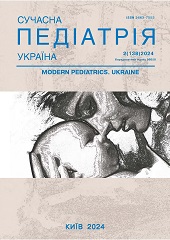Management of patients with juvenile idiopathic arthritis
DOI:
https://doi.org/10.15574/SP.2024.138.108Keywords:
juvenile idiopathic arthritis, pediatric rheumatology, pharmacological care, registryAbstract
Juvenile Idiopathic Arthritis (JIA) is considered one of the most severe and common rheumatic diseases in childhood. The hallmark signs of JIA are inflammation of one or more joints for more than 6 weeks in the absence of other possible causes of arthritis. Given that the etiology of JIA is uncertain, its pathogenesis multifactorial, and the experience with certain groups of drugs is limited, it is important to have consolidated national and international registries of patient information demonstrating experience in monitoring children with JIA.
The aim of the analysis of literature sources on the topic of accumulation and exchange of data on patients with JIA was to summarize and interpret data from existing national and international registries.
During the analysis, national registries of Sweden, the United Kingdom, Germany, and South America were analyzed, as well as the international Pharmachild project, which is the most comprehensive and informative database of patients with JIA. The development of local registries of patients with JIA remains relevant today, as it will improve the quality of monitoring such children and enable the identification of regional peculiarities in the course of the disease.
The establishment of international trial networks, such as PRINTO (Paediatric Rheumatology International Trials Organisation) and PRCSG (Pediatric Rheumatology Collaborative Study Group), the definition of recognized and standardized outcome measure and assessments of improvements, the validation of quality of life instruments, and the adoption of appropriate legislative measures have created the main prerequisites for better assessment of pediatric rheumatic diseases in the future.
No conflict of interests was declared by the authors.
References
Becker I, Horneff G. (2017). Risk of Serious Infection in Juvenile Idiopathic Arthritis Patients Associated With Tumor Necrosis Factor Inhibitors and Disease Activity in the German Biologics in Pediatric Rheumatology Registry. Arthritis Care Res (Hoboken). 69: 552-560. URL: https://acrjournals.onlinelibrary.wiley.com/doi/epdf/10.1002/acr.22961. https://doi.org/10.1002/acr.22961; PMid:27390133
Bogmat L, Shevchenko N, Holovko T, Nikonova V, Bessonova I et al. (2023). Comorbidity in children with rheumatic diseases: literature review and 10-year experience of own research. Child's health. 18(4): 297-304. https://doi.org/10.22141/2224-0551.18.4.2023.1603
Boiko Ya. (2020). Juvenile idiopathic arthritis: an expert's view of the problem. Thematic issue "Pediatrics". 5(56): 3. URL: https://health-ua.com/article/62883-yuvenlnij-dopatichnij-artrit-poglyad-eksperta-naproblemu.
BSR. (2023). UK JIA Biologics Register. URL: https://www.rheumatology.org.uk/improving-care/registers/juvenile-idiopathic-arthritis.
El Tal T, Ryan ME, Feldman BM, Bingham CA, Burnham JM, Batthish M et al. (2022). Consensus Approach to a Treat-to-target Strategy in Juvenile Idiopathic Arthritis Care: Report From the 2020 PR-COIN Consensus Conference. The Journal of Rheumatology. 49(5): 497-503. https://doi.org/10.3899/jrheum.210709; PMid:35105705
Horneff G et al. (2008). Safety and efficacy of combination of etanercept and methotrexate compared to treatment with etanercept only in patients with juvenile idiopathic arthritis (JIA): preliminary data from the German JIA Registry. Ann Rheum Dis. 68(4): 519-525. https://doi.org/10.1136/ard.2007.087593; PMid:18413440
Khyts A. (2020). Pediatric rheumatology: peculiarities of treatment of juvenile idiopathic arthritis and systemic lupus erythematosus in the light of modern health care reforms. Ukrainian medical journal. URL: https://www.umj.com.ua/uk/publikatsia-194964-dityacha-revmatologiya-osoblivosti-likuvannya-yuvenilnogo-idiopatichnogo-artritu-ta-sistemnogo-chervonogo-vovchaku-u-svitli-suchasnih-reform-ohoroni-zdorov-ya.
Magnusson B. (2014). Board of registry. The swedish paediatric JIA-registry. Pediatr Rheumatol. 12; Suppl 1: P5. https://doi.org/10.1186/1546-0096-12-S1-P5; PMCid:PMC4184246
Martini A, Lovell DJ, Albani S et al. (2022). Juvenile idiopathic arthritis. Nat Rev Dis Primers. 8(1): 5. https://doi.org/10.1038/s41572-021-00332-8; PMid:35087087
Marushko T. (2018). Juvenile idiopathic arthritis. Thematic issue "Pediatrics". 1(44): 39-41. URL: https://health-ua.com/article/36210-yuvenlnij-dopatichnij-artrit.
Minden К. et al. (2012). Long-term outcome of patients with JIA treated with etanercept, results of the biologic register JuMBO. Rheumatology. 51; 8: 1407-1415. https://doi.org/10.1093/rheumatology/kes019; PMid:22447885
Ruperto N, Martini A. (2004). International research networks in pediatric rheumatology: the PRINTO perspective. Curr Opin Rheumatol. 16(5): 566-570. https://doi.org/10.1097/01.bor.0000130286.54383.ea; PMid:15314496
Swart J et al. (2018). Pharmacovigilance in juvenile idiopathic arthritis patients treated with biologic or synthetic drugs: combined data of more than 15,000 patients from Pharmachild and national registries. Arthritis Res Amp Ther. 20(1). https://doi.org/10.1186/s13075-018-1780-z; PMid:30587248 PMCid:PMC6307151
Van Straalen JW et al. (2023). Juvenile idiopathic arthritis patients with positive family history of autoimmune thyroid disease might benefit from serological screening: analysis of the international Pharmachild registry. Pediatr Rheumatol. 21(1). https://doi.org/10.1186/s12969-023-00802-1; PMid:36810111 PMCid:PMC9945712
Zhao JH, Ma S, Li CY, Zhang HC, Zhao LJ, Zhang ZY. (2023). Clinically approved small-molecule drugs for the treatment of rheumatoid arthritis. Eur J Med Chem. 256: 115434. https://doi.org/10.1016/j.ejmech.2023.115434; PMid:37148849
Downloads
Published
Issue
Section
License
Copyright (c) 2024 Modern pediatrics. Ukraine

This work is licensed under a Creative Commons Attribution-NonCommercial 4.0 International License.
The policy of the Journal “MODERN PEDIATRICS. UKRAINE” is compatible with the vast majority of funders' of open access and self-archiving policies. The journal provides immediate open access route being convinced that everyone – not only scientists - can benefit from research results, and publishes articles exclusively under open access distribution, with a Creative Commons Attribution-Noncommercial 4.0 international license (СС BY-NC).
Authors transfer the copyright to the Journal “MODERN PEDIATRICS. UKRAINE” when the manuscript is accepted for publication. Authors declare that this manuscript has not been published nor is under simultaneous consideration for publication elsewhere. After publication, the articles become freely available on-line to the public.
Readers have the right to use, distribute, and reproduce articles in any medium, provided the articles and the journal are properly cited.
The use of published materials for commercial purposes is strongly prohibited.

